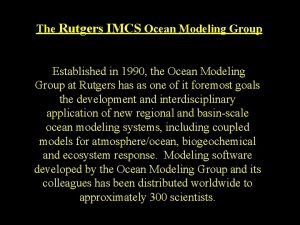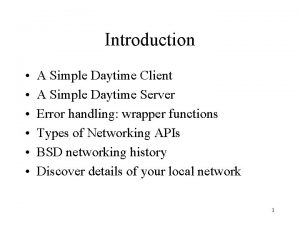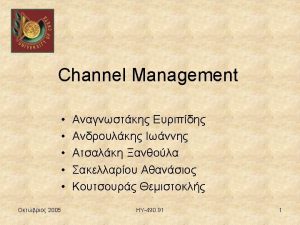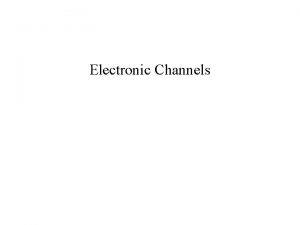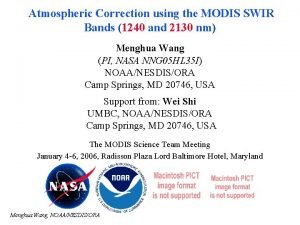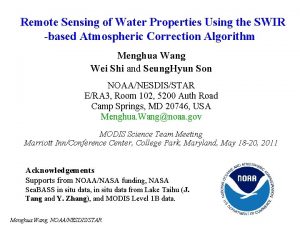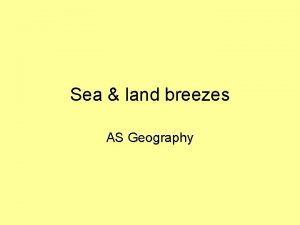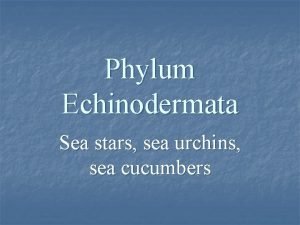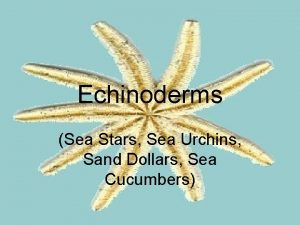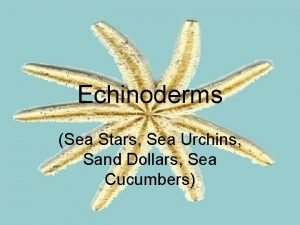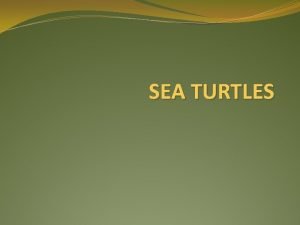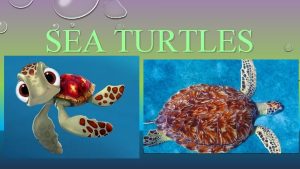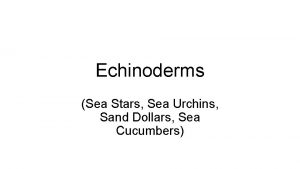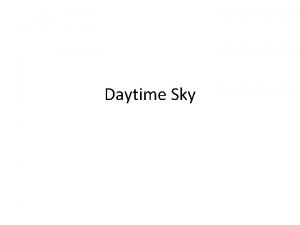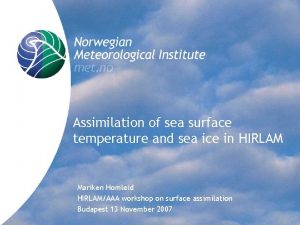Use of SWIR Channels for Daytime Sea Surface



















- Slides: 19

Use of SWIR Channels for Daytime Sea Surface Temperature Retrieval Prabhat Koner ESSIC, UMD, College Park, USA NASA Award 80 NSSC 18 K 0705 (PDSST)

What is Physical Deterministic SST? • Sea Surface temperature retrieval using “Deterministic” inverse method from satellite imager measurement (New initiative and different school of thought). • Most of the satellite derived SSTs are generated using “Regression”, i. e. Stochastic inverse (complementary of “Deterministic”). • “Stochastic” inverse (Bayesian, Regression and/or AI/NN) is based on a set of instances. Where error is treated as definite information for most of the implementations. This is a fundamental flaw. • Deterministic inverse is based on physical model and applied at individual pixel level. • Moreover, a centaury old RT physics is well matured for applying deterministic inverse in satellite retrieval.

Parametric form of PDSST b) TTLS for 6 measurements with 3 unknowns Analytical error estimation and information content at individual retrieval

Additional parameterization effects Comparison of MTLS (2 variables) and TTLS (3 variable) using a month of MODIS matchups and EXF

Advantages of PDSST over Prevalent 1. Substantially reduces SST error by adapting to “local” atmospheric information through NWP (Numerical Weather Prediction) data. 2. Ensures the balance between information content and noise of the retrievals: i. e. sensitivity is close to 1 when the initial guess (IG) is “far” from truth. 3. Unprecedented capability as “Aerosols” can be explicitly included in the forward modeling calculations as well as in the retrieval vector. 4. Straightforward option to include both multiple channels and multiparameter to reduce uncertainty/error in SST. 5. Provides meaningful estimates of error and information content analysis at pixel level. 6. Automatically adapts to improvements in RT modelling, instrument calibration, improvements in cloud detection, etc. , due to case-by-case dynamic estimates of noise using SVD at the solution time.

PDSST suite on MODIS-A (Night) 1 millions of matchups were studied. PD SST suite increases average data coverage from ~9% to 18% & simultaneously reduction of RMSE from 0. 51 to 0. 34 K. Koner, P. K. , and Harris, A. Sea surface temperature retrieval from MODIS radiances using truncated total least squares with multiple channels and parameters, Remote Sensing 2016, 8(9), 725. doi: 10. 3390/ rs 8090725.

Swath retrievals: North Atlantic No. of Buoy matches: 28 Methods PDSST OPR 11 OPR 4 Match – 1 -0. 14 1. 65 1. 22 Match - 2 -0. 02 0. 17 0. 25 Match - 3 -0. 51 -0. 23 -0. 25 RMSE (K) 0. 31 0. 97 0. 74 As example of cloud leakage by prevalent algorithm, which increased the error statistics.

Dynamic area SSTs: California Coast Meth. 1 PDSST -0. 26 0. 13 0. 16 OPR 11 0. 01 OPR 4 -0. 29 2 -0. 20 -0. 05 0. 18 0. 25 -0. 20 3 0. 22 0. 05 0. 07 0. 13 0. 06 4 0. 28 0. 13 -0. 28 0. 08 -0. 28 5 0. 09 0. 05 0. 00 0. 15 -0. 33 6 -0. 01 -0. 26 -0. 06 0. 30 0. 04 7 8 0. 10 -0. 03 -0. 15 0. 03 = 24 out of 47 0. 17 -0. 09 -0. 13 -0. 25 9 RMS 0. 10 -0. 29 0. 16 0. 44 0. 22 0. 00 0. 21 Prevalent algorithm is highly screening the retrieved SST near coastal area, which is most important for oceanic studies.

Indian Ocean SSTs: IIOE-2 Methods PDSST OPR 11 OPR 4 Match - 1 -0. 17 -0. 09 0. 05 Match - 2 -0. 08 0. 26 Match - 3 0. 16 Match - 4 0. 05 Prevalent algorithm is totally screened the Bay of Bengal. RMSE 0. 12 0. 20 0. 19

Experimental Filter: Cloud Free set Complete Cloud-free condition is pre-requisite to compare and develop retrieval and cloud detection algorithms This concept has been published in several peer-reviewed publications, e. g. P. K. Koner et al. Hybrid cloud and error masking to improve the quality of deterministic satellite sea surface temperature retrieval and data coverage, Remote Sens. Environ. , vol. 174, p. 266278, 2016

Revisiting Split-Window Technique 1. SST Jacobian is proportional to transmission. 2. Fundamental assumption for Split window: 11 µm is a window channel. 3. How to define window channel: perhaps penetration depth concept. 4. Quality of SST retrievals using SW method is questionable. Observations: ~40% measurements of 11 µm below penetration depth: fundamental assumptions doesn’t hold. 3. 9 µm measurement is must to know SST. Additionally, Planck function 3. 9 µm is steeper than that of ~11 µm

Hypothetical SST retrieval Functional Form of Split-Window Operational SST producers often employed the piecewise regression using multiple coefficients sets to reduce these errors, but the quality of these retrievals is still questionable

CRTM Day time simulation 1. Specular component of CRTM is satisfactory. 2. Ocean surface is quasi-specular and BRDF component in CRTM has to be improved.

CRTM Day time simulation

GOES-13 daytime SST retrieval Prabhat K. Koner, Andy R. Harris & Eileen Maturi, Hybrid cloud and error masking to improve the quality of deterministic satellite sea surface temperature retrieval and data coverage, Remote Sensing Environment, vol. 174, p. 266 -278, 2016.

Conclusions: • 2 -3 times information gain is achievable using PDSST as compared to presently implemented stochastic retrievals. • Information retrieval from satellite data even more for dynamic areas, where need the most. • Additionally, our other work on simulated profile retrievals from satellite sounder measurement using deterministic retrieval shows an outstanding improvement. • Perhaps, it is time to think to paradigm-shift in satellite inverse problem to open a new door for Geo-science research.

Thank You Questions?

Regression based Retrieval

Extra
 Richard 'dick' marcinko
Richard 'dick' marcinko Daytime aid to navigation
Daytime aid to navigation Navigation
Navigation Aegean sea troy
Aegean sea troy What is asias largest desert
What is asias largest desert Sea anemone jellyfish
Sea anemone jellyfish Marlin symbolism
Marlin symbolism Sea stack sea arch
Sea stack sea arch Rutgers ocean temperatures
Rutgers ocean temperatures Lateral surface area of a prism formula
Lateral surface area of a prism formula Spin coat
Spin coat Surface area of a cone
Surface area of a cone Fspos
Fspos Typiska novell drag
Typiska novell drag Nationell inriktning för artificiell intelligens
Nationell inriktning för artificiell intelligens Returpilarna
Returpilarna Varför kallas perioden 1918-1939 för mellankrigstiden?
Varför kallas perioden 1918-1939 för mellankrigstiden? En lathund för arbete med kontinuitetshantering
En lathund för arbete med kontinuitetshantering Personalliggare bygg undantag
Personalliggare bygg undantag Personlig tidbok fylla i
Personlig tidbok fylla i








